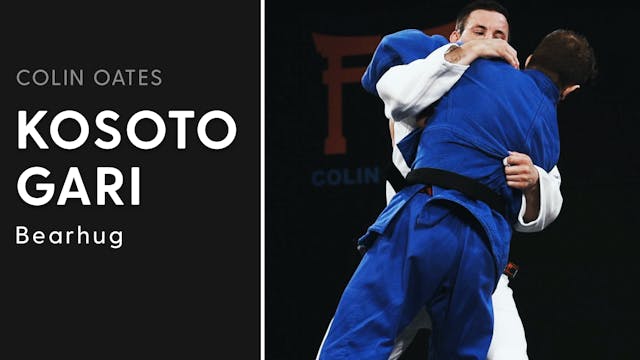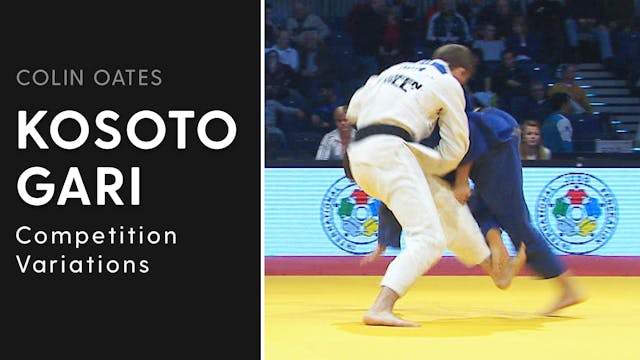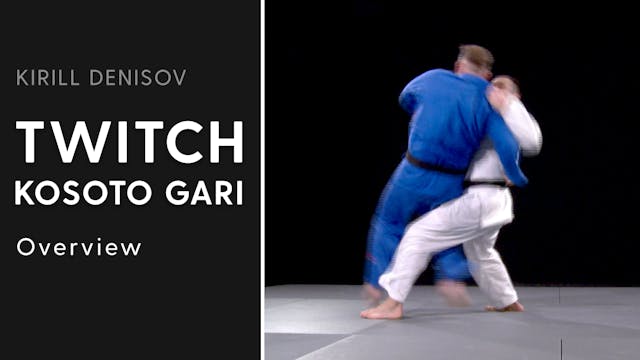Colin Oates’s Kosoto gari is a three part trap; it starts by forcing Uke to pull away, then locks their lower leg into position, and finally the sticking to their foot - all of which contribute to the momentum of this throw.
The initial trap comes from the threat of a standard direction of attack, as demonstrated here.
By drawing the partner onto him, Oates is baiting them into resisting, and then reacting and moving in the opposite direction.
In getting a reaction from the partner the trap has been sprung. Oates says that the best thing for the partner to do would be not to move at all, as that would leave him with little attacking options.
But, he says, that is not human nature. The inclination is to move away from the threat.
And, as the partner moves, they generate momentum.
Tori’s entry should be a strong and balanced jigotai position.
The idea is to then move with the partner, chasing them down as you catch their foot.
And this is when the sticky foot Kosoto comes in to play.
Now it’s a case of staying in contact with the partner’s foot as you hop them off balance.
He describes the movement of the hands as a steering wheel motion, with both arms working in sync together.
The left arm is pulling down on the collar, and the right arm up on the sleeve, both in a circular motion
The breaking of uke’s posture comes from their own movement combined with that of tori’s.
Capitalising on Uke’s momentum, and directing them to the floor.
Oates says that when it comes to the upper body it works well to imagine that you are holding onto a stick with both hands, they should feel like they are connected together, not steering independently.
The judogi is nice and tight, he adds, meaning that you can move your partner around easily. See how there is a direct line from one hand to the other
Locking the partner’s leg in place is the second part to the trap.
By positioning your foot on the outside of your partner’s foot, and your knee on the inside of their leg, you create an axis, similar to that of an armlock.
This is uncomfortable for the partner and is another way of encouraging them to pull away.
Once he’s attacked, and connected with the foot, Oates says that what the partner wants to do is get their foot back down on the mat.
All this does is add to the momentum and impact of the throw.
Their bodyweight is committed to dropping as they attempt to stabilise themselves, and when they are unable to escape from the sticky foot they break their own balance.
This is the final stage of the three part trap. The first being the change in direction, the second being the lock of the partner’s leg and the third being the sticky foot.
And here it is when it all comes together in a realistic competitive situation.
Up Next in Watch All
-
Bearhug | Kosoto Gari | Colin Oates
Colin Oates’s bear-hug Kosoto gari is used against left handed opponents that come out in a right stance. In this situation an opponent would normally be looking to win the grip-fight, taking a high left handed grip, before switching to their preferred left stance.
So the response from Oates is ...
-
Competition Variations | Kosoto Gari ...
In this clip we see how Colin Oates used his Kosoto gari in compeititon, and how it varied as he adapted it to each specific scenario
On his way to winning the bronze medal at the 2013 Rijeka Grand Prix, Colin Oates produces a beautiful sticky foot Kosoto gari in the eliminations.
After pulling...
-
Overview | Twitch Kosoto Gari | Kiril...
Five time World medallist Kirill Denisov’s Kosoto gari comes from the threat of his highly effective Uchi mata.
His twitch for the forward throwing Uchi mata gets the reaction in the opponent that allows for the rear throwing Kosoto.
Denisov has two main variations from the twitch.
The first ...




1 Comment